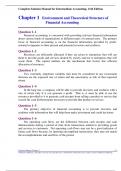Tentamen (uitwerkingen)
Solution Manual For Intermediate Accounting, 11th Edition by David Spiceland, Mark Nelson, Wayne Thomas, Jennifer
- Vak
- Instelling
Solution Manual For Intermediate Accounting, 11th Edition by David Spiceland, Mark Nelson, Wayne Thomas, Jennifer Both online and in PDF Immediately available after payment . 100% Money Back Guarantee
[Meer zien]




